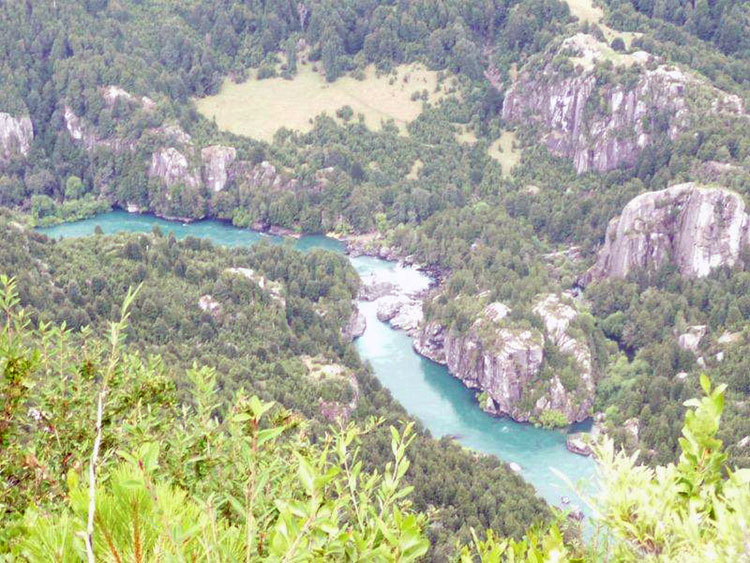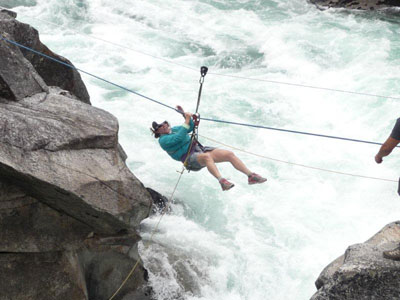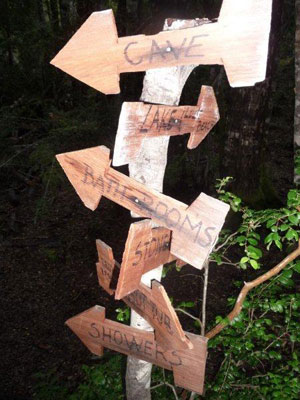Running the rapids on Chile’s picturesque Futaleufú River
This article appears on page 32 of the April 2013 issue.
by Marlene Lomas; Honolulu, Hawaii
In 1993, my late husband and I ran the big white water on the Bío Bío River in Chile. While we were there, we heard tales of the legendary rapids of the Futaleufú River.
Almost 20 years later, the dream of running this turquoise-colored, world-class white water became a reality for my friend Pat and me when we signed up for the Jan. 27-Feb. 5, 2012, expedition run by Earth River Expeditions. The river did not disappoint.
Making arrangements
Earth River (800/643-2784), based in New York City, has been running the Futaleufú since 1991. While they had an impressive website, I must say that pre-trip communications were somewhat lacking. Emails were not always answered promptly; nevertheless, when I called their office number, Eric, one of the owners, usually answered the phone.
The price for a 10-day trip (with departure from the US on day one and the return home on day ten) was $3,400, including a commuter flight from a small charter airport in Puerto Montt to Chaitén, Chile, and return; all meals; beer and wine; transportation; sleeping bags with liners; wetsuits, and guides. International flights and the internal flight to Puerto Montt were not included.
To get to Santiago, Pat and I both used frequent-flyer miles for our Delta Air Lines flight. The round-trip airfare from Santiago to Puerto Montt on LAN Airlines was $322.
On the way down, we spent one night in Santiago at the hotel Mito Casa (Providencia 139) in the Providencia area. It had a great location and friendly staff and was nice and quiet, but there was no elevator and there were several flights of stairs leading to our room. The cost was $140 for a double room, which included a loft bedroom and a very modern bathroom.
I booked the hotel online (Booking.com), then paid the hotel directly on arrival. We had to miss the included breakfast because our flight to Puerto Montt left very early the next morning.
Our trip started out a bit rocky, as the Earth River representative who was supposed to meet us in the Puerto Montt airport was nowhere to be found when we arrived. We tried to call her but kept getting cut off on the pay phone we were using. We ended up sitting in the airport for 3½ hours until Maria finally materialized.
She rushed the final four people of our group of 15 into a taxi and off we went to La Paloma Airport, where we repacked our things into small black duffels and took off for Chaitén. On arrival in Chaitén, we were welcomed by heavy rain and a man who spoke only Spanish. We headed out on a mostly unpaved road for the 3-hour journey to meet our group at the first of four private camps that Earth River owns on the Futaleufú. Suffice it to say that upon our arrival at Terminador camp, dinner had already been served to the rest of the group and we were off to a soggy start.
When traveling in Patagonia, one must be ready for all kinds of weather. The extensive list we were given of clothes and equipment to pack insured that we were prepared.
We were shown to cabin No. 9, which sat above the river along a dramatic tree-lined bluff. The raging river was so loud that even with earplugs I could hear it all night. The “Fu,” known for its beautiful water, was a dirty brown due to all of the rain.
An exciting intro
The next day was to begin with a “safety flip drill,” to insure we could right our kayaks if they flipped over, but because it was still raining and cold, the itinerary changed to inflatable 2-man kayaking down a tributary of the Futaleufú. Having done this many times before, we felt comfortable.
After lunch, we each were assigned to a raft. Pat and I were lucky enough to be in a Cataraft with the head guide, Roberto, as well as a married couple from New York City, David and Natalya. This would be our “team” for the entire trip.
The beauty of the Cataraft is that you sit up higher than you would on a normal kayak, so you can more easily see the white water downriver. All the rafts had foot cups in them, which allowed us much more stability in the raft.
Each raft had a guide in the back with a long set of oars and four to six paddlers in front who provided the power by paddling their hearts out.
chile2
I have to say that all of our guides were world-class boatmen who could guide a trip on any river on the planet. They did an excellent job maneuvering us through the most continuous Class IV and V rapids I have ever encountered in almost 30 years of river trips.
We also had three guides running safety in individual Catarafts, one of whom was 19 years old and in training. The seventh boatman was a professional videographer who went ahead of us in a kayak, then set up and took heart-stopping video of our adrenaline-filled ride through the many rapids.
On the last night of the trip, we were able to view most of what we had experienced. (The video and still photos were available for purchase.)
The following day we were scheduled to run the Class V Inferno Canyon. Due to the inclement weather, the guides declined to do this section, as the water was just too high. Instead, we again ran the section we had done the day before.
Natalya and David decided to sit this one out, so it was just Pat, Roberto and me paddling in our boat. We had a blast, and finally the weather started to improve.
Out of the water
After getting off the river, we had a short visit to the town of Futaleufú. We then moved to our next location, known as Cave Camp. This camp sits just downstream of the giant, unrunnable Class VI Zeta rapid.
Enjoying a glass of wine while sitting on the rocks and watching the guides ghost boating empty rafts through the giant water to check the current was a memorable moment!
This camp also featured a large cave with a fire pit, where we all could comfortably eat dinner and stay dry, as well as two hot tubs, one a chemical-free stone hot tub and the other a wooden hot tub that could hold up to 18 people.
The showers at Cave Camp had burnt down shortly before our visit, so only one cold shower was available. Also, the flush toilets were a long hike away from our riverside cabin. Yes, this trip is not for those seeking luxury or for the nonadventurous.
The following days featured some of the highlights of the trip. We started our next morning with a Tyrolean traverse across the Class VI Zeta rapid. After each being fitted with a climbing harness and rafting helmet, we pulled ourselves across a rope stretched between sheer granite walls. Halfway across, we were encouraged to let go, swing our legs up over the rope and hang upside down — another first for us!
After everyone was safely across, we began a 1,500-foot vertical hike up to the Tree House Camp. The hike provided spectacular views of the river, and, after less than two hours of hiking up through the forest, we arrived.
I was promptly encouraged to jump into the Lake of the Frogs before plunging into the wooden hot tub. It felt great, until I had to get out of that hot tub and into the cold air!
The Tree House cabins were the most impressive accommodations of the trip. There are eight hexagon-shaped tree houses built 35 feet up in the air.
Fortunately, I had taken the advice of one of the guides and booked a one-hour massage (25,000 pesos, or $50) with Diana for this day. It was well worth it, and what a magical place to enjoy a much-needed rubdown!
This camp also had a very nice gazebo with a fire pit, around which the group would gather to eat, drink, talk and try to dry clothing.
Another guided hike took us to Tree House Camp Canyon Overlook, where we had hoped to see condors. Instead, we got views of the surrounding mountains and seven miles of the river canyon.
High adventure
The following day we hiked back down the mountain, ending the walk at a 250-foot-long zip line. We each took hold of a loop handle attached to a pulley over our heads, got a running start and jumped off a 25-foot-high cliff, shooting 250 feet down the angled rope above the river while waiting for head guide Roberto to yell, “Drop.”
Once in the river, we had to swim against the current to the shore, then race to the nearby stone hot tub to warm up. It was not as scary as it might sound, though our next adventure was a bit more intimidating.
Right after lunch, Pat and I set off in the first of two groups for the big event. After a safety briefing and fitting of climbing harnesses, we began our three-section rock climb.
I was so proud of Pat, who, at 66 years old, was the first one to go up — and down! After climbing up the back side of the 320-foot-high granite spire, we prepared for the rappel down. The view from the top of the Torre de los Vientos (Tower of the Winds) was truly magnificent.
The descent involved a two-stage rappel. The hardest part was getting over the lip at the top. Once I felt I could trust the rope to hold me, it was great fun “jumping” down the wall. Thankfully, the weather cooperated, and the talk around the campfire that evening centered on this thrilling new accomplishment by the first-timers.
An exciting ending
The following two days consisted of running many more exciting Class IV-plus and Class V rapids and moving to our final home for the last two nights, Mapu Leufu Cliff Camp. There, Pat and I enjoyed a cabin with a fabulous view of the river and mountains.
We spent one afternoon canyoneering up the Rio Blanco slot canyon. I have to say this was my least favorite activity, as, even with the special 5.10 brand of river shoes we had been encouraged to purchase, this was a slippery slog. We also wore our life jackets and helmets.
As all of the 30- and 40-something guests took off up the river and went around the bend, we gave up on going any farther. Juanito, one of the boatmen, accompanied us back down the river and across the manual cable car that took us back to camp.
Our last day on the river demanded that we do the flip drill before tackling the many Class V rapids, including Terminador, Mas o Menos and Casa de Piedra. Suffice it to say there was so much action in this section of the river that time just flew by.
On only one rapid did Roberto’s voice get so loud — yelling, “Dig! Dig harder!” and “Back paddle!” — that I thought we might be in trouble. However, the foot cups in the bottom of the boat and the stability of the Cataraft kept everyone in the craft, albeit some landed in the bottom of the boat.
Before we knew it we were back at camp preparing for our final dinner. Our farewell dinner consisted of a traditional Chilean asada (a sheep roasted over a fire) along with freshly made pisco sours.
The food on the entire trip was very good, and there was always plenty of Chilean red wine and beer available. Some of our other dinner entrées were steak, lasagna, salmon and pasta. Lunch was often a build-your-own sandwich with cheese, avocado and Italian hard salami, and we had stuffed peppers and eggplant at the Tree House Camp.
The final day was very rushed — not such a great ending to what had been the most memorable river trip of my life.



